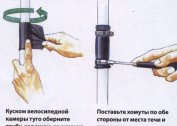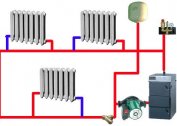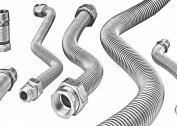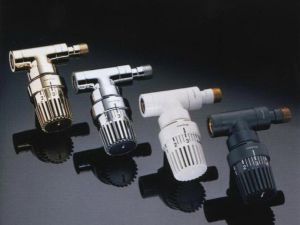
The operation of an autonomous heating system may not always be stable. Sudden changes in temperature and, as a result, pressure, affect the integrity of the connection of pipes and radiators. To prevent this, a special protective device is necessary - a safety valve for the heating system: selection, installation is included in the mandatory list of installation works.
Bypass Valve Functions
During heating, the coolant expands - a natural increase in volume leads to an increase in pressure on the inner walls of pipelines and heating devices. If a certain value is exceeded (usually about 3.5 bar), the joints are not sealed, which leads to gusts and emergency situations. For the timely discharge of excess hot water, it is necessary to install a safety valve for the heating boiler, or, as it is also called, a bypass valve.
It should perform the following functions:
- Timely remove excess coolant, while reducing the pressure inside the system;
- Have the ability to customize. In an autonomous system of a private house, the safety valve for heating must have the function of manually setting the maximum permissible pressure value;
- Reliability of operation. The design and material of manufacture must ensure the normal operation of the safety valve for the heating system.
The choice of a particular model is affected by the characteristics of heat supply - the value of the optimal and maximum pressure in the pipes, the location of the expansion tank, the length of the line and its type (single-pipe, two-pipe or collector). But before you purchase a device, you need to study the parameters that characterize a safety valve for heating: the principle of operation, design and installation specifics.
Types and design features of valves for heating
Currently, for the operation of the bypass valves, two essentially different operating principles are used - spring and lever-cargo. The latter is most often used for large central heating mains. Consider the specifics of each of them.
Spring valves
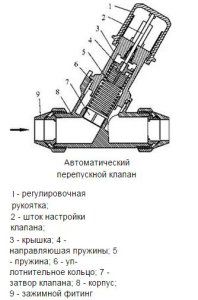
This relief valve for the heating system is installed in private homes and apartments.
The principle of operation of this mechanism is as follows. The flow of fluid acts on the valve cap, the movement of which is limited by the spring. As soon as the pressure value exceeds the compression force of the spring, the rod rises. As a result of this, the coolant will enter the outlet pipe. After stabilization of the internal volume of water, the valve spring of the safety valve for the heating boiler will return the valve to its original position. As a result, the flow of coolant ceases to flow into the outlet pipe.
Lever-weight valve
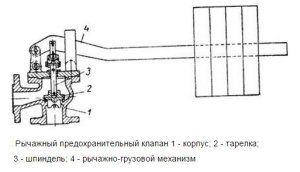
This type of safety relief device is used for pipelines of large diameters (from 200 mm). In it, instead of a spring, a load with a different mass exerts a force on the rod.
Before choosing a safety valve for a heating system with a similar design, it is necessary to familiarize yourself with the specifics of its operation. First of all, this is a rough adjustment of the critical pressure value. This can be done by changing the mass on the external lever. In spring models, this can be done by turning the adjusting cap.Moreover, the minimum change in pressure can be 0.2 bar.
Choosing the best model
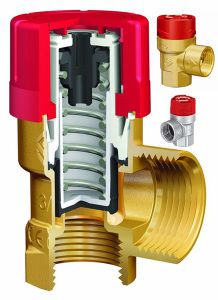
The process of selecting a safety valve for a heating system should be based on its performance. For this, in addition to the heating parameters, you need to familiarize yourself with the regulatory document - GOST 24570-81, which describes the selection criteria in detail.
Since the lever-load mechanisms are used in large pipelines, the conditions for spring models of the safety valve for the heating boiler will be considered. They are divided into several main points - the requirements for the mechanism, pipelines and material of manufacture.
Mechanism
In the design of the bypass valve, the main elements are a spring, a stem and a plate, which is affected by the pressure of the coolant. Together, they must form a reliable mechanism with precisely calculated parameters. The main ones are the operating conditions of the safety valve for the heating system, selection, installation.
There are two stages in the operation of the device - the time the rod begins to move and the passage is completely opened to remove excess water. The percentage difference in pressure between them is the main characteristic of the valve. In addition, it depends on the nominal pressure in the heating system.
- Up to 0.25 MPa - 15%;
- Over 0.25 MPa - 10%.
The higher the working pressure, the faster the device should respond. In this case, the spring coils of the safety valve for heating should not be in contact with each other.
The adjusting mechanism is necessarily protected from the direct influence of hot water.
Since during a long idle time, a “sticking” spring is possible, then the device must have a mechanism for checking its operability (a rod for manually pulling the spring).
Pipeline supply
Before choosing a safety valve for the heating system, you need to correctly determine its diameter. It should not be smaller than the inlet pipe itself. Otherwise, the hydraulic resistance will not allow the device to perform its functions normally. Be sure to protect the relief valve for the heating system from freezing - the effect of subzero temperatures negatively affects the operation.
During installation, the safety valve of the heating system should only slope towards the boiler. This will ensure minimal hydraulic loss when pressure is applied to the plate.
Production material
The case is most often made of brass, since this material has a minimum coefficient of thermal expansion, is reliable and affordable. The selection of the safety valve of the heating system for this parameter is very important - when the maximum pressure is reached, the housing must not be destroyed.
For a heating safety valve, the principle of operation also lies in the timely adjustment of the set pressure value. To do this as quickly as possible, the control unit is made of special heat-resistant plastic. It does not change its geometry and remains rigid even at maximum water temperature.
Features of installing a safety valve
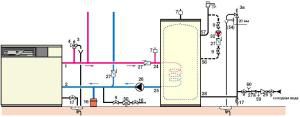
Professional installation of the safety valve in the heating system consists in taking into account not only its characteristics, but also the operation of the expansion tank. As soon as the latter can not expand the internal volume of the pipes, the bypass valve should work and remove the excess water from the pipes.
According to the rules, a safety relief valve for the heating system must be installed immediately after the boiler outlet pipe (in the diagram, these are elements 3 and 4). The optimal distance between them is 20-30 cm.For visual inspection, a pressure gauge is mounted in front of it. According to his testimony, you can determine the current state of the system.
There are certain rules for installing a safety valve in a heating system:
- Before the device and the boiler it is impossible to mount shut-off equipment - valves, taps, etc .;
- To remove excess water, a drain pipe is installed on the outlet pipe of a correctly selected safety valve for heating. It can be connected to a return or sewer pipe;
- In a closed gravity system, the safety heating valve is installed at the highest point.
In addition, it is necessary to periodically check the status of the mechanism. For spring models, “sticking” of the plate with the walls of the body is characteristic. This increases the maximum opening pressure of the safety valve in the heating system. As a result, if the permissible pressure value is exceeded, the device will not work.
If the number of emergency descents was 7-8 times - experts recommend replacing the valve. This is due to the natural wear of the springs and plates.
To a greater extent, the latter relates to the operating conditions of the safety valve for heating than to the principle of its operation. However, without this, even with perfectly completed installation, the likelihood of incorrect operation of the device increases.
What should be considered when selecting a safety valve in an autonomous heating system? Compliance with its technical specifications operational. It is also important to correctly connect it to the pipe. To do this, it is best to use a traditional tub pipe. The FUM tape may not withstand the temperature effects, resulting in a leak.
To better understand the principle of operation of the safety valve, it is recommended to watch a video about the features of the design and functioning of the spring model:
